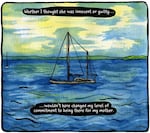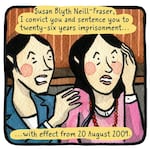
"When I see news stories, I'm like a lot of people. I think about the victim and who's been charged. I hadn't really considered what it would be like to be in that situation."
Courtesy of Eleri Harris.
On the other side of the world, in a city roughly the size of Corvallis, a murder mystery has kept news-watchers and voyeurs on the edge of their seats for eight years. A wealthy scientist from Hobart, Tasmania disappeared in 2009. The ensuing investigation was, in Tasmanian terms, the trial of the century.
But when Portland-based artist and journalist Eleri Harris took on the story, she aimed to bring out the less-told tragedies of the family involved in the case. Her seven-part serialized comic, called "Reported Missing," is gorgeously rendered and binge-worthy. The story lays out the case in patient detail, along with the surprising developments that keep the case alive to this day. It's told mostly from the perspective of the victim's step-daughter, who remains convinced of her mom's innocence.
Eleri Harris is a deputy editor at the Nib, a website featuring political cartoons and nonfiction comics. If you're hungry for more, the full conversation is on this episode of "Think Out Loud."
Q&A with Eleri Harris
April Baer: Tell us about the case.
Eleri Harris: So, Bob Chappell, a Hobart radiologist, was on his boat one night. And the next morning he was not on his boat. The boat was found listing in the water, half-sinking, and later on, his partner of 20 years was charged with his murder and convicted.
Baer: His partner was Sue Neill-Fraser. You went to school with Sue’s daughter, Sarah. Did you know Sarah very well?
Harris: We went to high school together, but we're now in our 30s, and I hadn't seen her in ten years before I sat down to interview her. But I'd obviously heard a lot about her. It's a sensational news story ripping through a very small community. I'm actually a reporter by trade. I used to work in public radio. I wanted to look at the story from the perspective of Sarah, and introduce myself as a character. I'm really looking at the emotional side of this case: What's it like to have your mum convicted of murder? And what's it like to have these ripple effects through your life? That has a huge impact on, not just the victims or people convicted, but also their family members. The best thing you can use a comic for is the emotional impact of things.

A panel from "Reported Missing", by Eleri Harris.
Courtesy of Eleri Harris.
Baer: We’re not going to give away how you wrap up the narrative, but did you come to any conclusions yourself about what happened? At what point did you make your narrative decision about how to wrap up the story?
Harris: I've been working on this piece for a long time. I started doing interviews with Sarah when absolutely nothing was going on. As far as I knew, her mother was going to be in prison. As time went on, the law was changed in Tasmania, which allowed Sue to have another appeal. Then other stuff has happened, a lot of drama around the case, the police have made arrests, that led to a very dramatic ending I wasn't expecting. That's the kind of thing that happens in real-life stories.

"There are things comics can do that are hard to do with print and other types of media. In fact, there have been documentary films and things about this story."
Courtesy of Eleri Harris.
Baer: So much of the emotional power you get our of this comes out of your art style. It’s so beautifully, deceptively simple. The characters are colorful and expressive, but there’s a simplicity to them that belies the complexity beneath the surface.
Harris: Well, there's an element to this that's just my drawing style, but I did want to do this comic in watercolors, because I wanted to be able to convey different kinds of lighting. I kind of like the idea of tricking people into reading something that's actually a true-crime story by making it look like a children's book. I think there's a lot to be said for dot eyes. And there's been a lot of academic research into the idea of a dot-face cartoon character being one that most people cam empathize with more. They can put themselves in their shoes because it's a much more simple drawing. Sarah — she does look a bit the way I draw her, but at the same time, this is character with a dark pony tail. It could be anyone you know.

